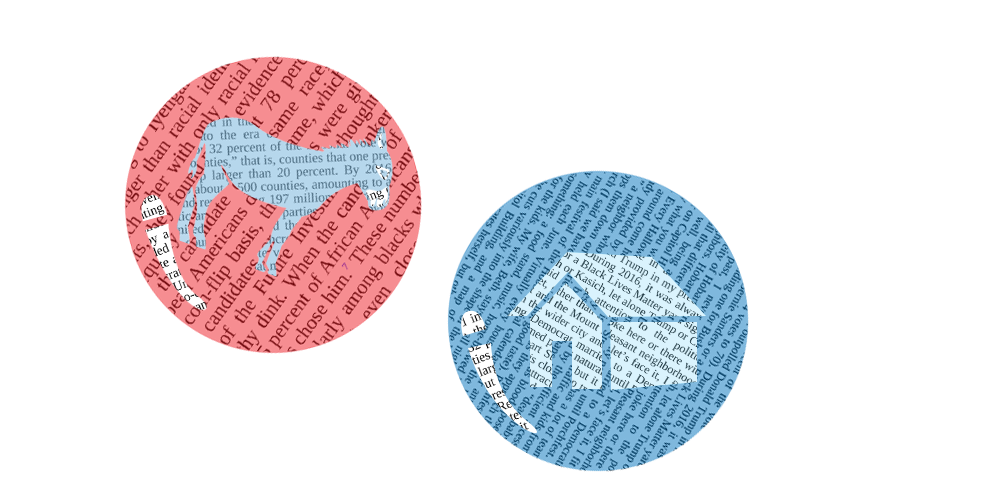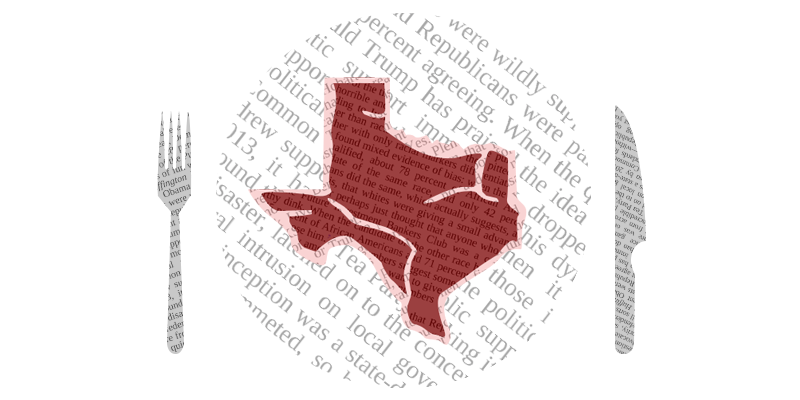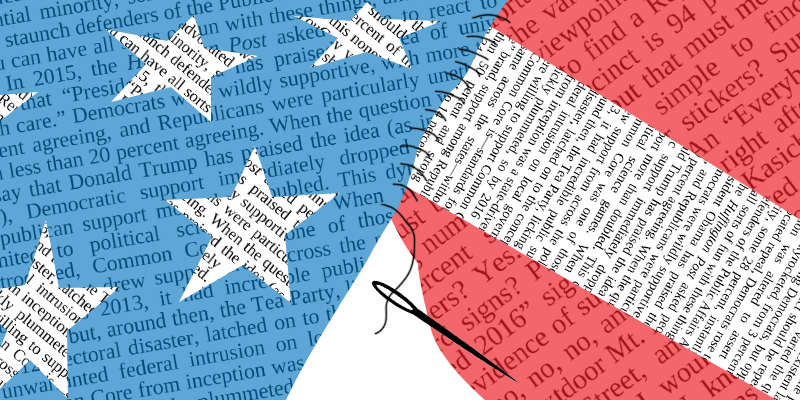In the wake of the 2016 election, journalists and political commentators have been falling all over themselves to report on the plight of the so-called “white working class.” I hate to use the scare quotes, but the term is much less distinctive than it once was. We are all proletarians now: economic instability is keenly felt all over the country, at all levels of society, and not just among white people, either. Recent bestsellers like Arlie Hochschild’s Strangers in Their Own Land and J.D. Vance’s Hillbilly Elegy prove that there is a considerable market for books addressing the economic, political, and cultural gaps between city and country, between left and right. The latest of these is Ken Stern’s Republican Like Me: How I Left the Liberal Bubble and Learned to Love the Right.
Stern, the former CEO of NPR and a lifelong Democrat, was inspired to write the book after realizing that while his posh Washington D.C. neighborhood celebrated diversity of all kinds, he didn’t personally know any conservatives or even know anybody who did. He decided to take a year-long trip through red states to better understand the ways of the right. Stern’s approach is well-intentioned but essentially flawed — just because he happens to live in a liberal neighborhood doesn’t mean that he’s the only one living in a bubble.
The title’s allusion to John Howard Griffin’s Black Like Me is a bit galling, but it accidentally touches on an important irony in understanding modern conservatism. Since at least the ’90s, right-wing media has gained a lot of momentum by claiming that their conservatism makes them cultural pariahs and bemoans to audiences of millions that no one is listening to them. A quick glance through cable news ratings, radio markets, Congressional races, and bestseller lists suggests otherwise. This passive-aggressive, contradictory attitude is one of the striking paradoxes of right-wing discourse, but Stern doesn’t address it because he’s too busy taking the assumed victimhood at face value.
A diversity of political opinion is democratically healthy, but it’s not as if conservatism doesn’t thrive in bubbles of its own. Plenty of districts in, say, Texas or Mississippi are redder than rare steak. It begs the question — why are liberals always the ones who must leave their bubbles to understand the “real” America? Surely American life is just as real in Brooklyn or San Francisco as it is in Memphis or Omaha. Why does political outreach only go in one direction? If the 2016 election had gone the other way, as it very nearly did, I rather doubt we’d be seeing a national trend of Trump supporters doffing their MAGA hats and getting in touch with their feminine side. Hillary Clinton paid dearly for her “basket of deplorables” remark, but this was small potatoes compared to what was routinely shouted at Trump rallies, with encouragement coming from both behind and in front of the podium. Evidently, our political culture has decided that empathy is the exclusive responsibility of the left.
The book flap advertises that Stern “shot a hog in Texas and stood in a pit row at a NASCAR race.” His account of his clumsy attempts to fit in is amusing, but the story of a city slicker going native is tellingly superficial, exchanging one arbitrary cultural signifier for another. Especially in our postmodern political world, what you eat, what you wear, or what sports you say you enjoy are ways of implicitly reassuring the audience that you’re on their side, whether you actually are or not. Plenty of politicians pamper the elite with lavish economic policies at the expense of poor and working people but win reelection by mastering the pose of good-old-fashioned, aw-shucks Americana.
There is a bit of a Victorian-era mentality in Stern’s project as well, of the bourgeoisie finding rejuvenation from romping among the common folk, a trope that stretches from Tolstoy to Titanic. Stern’s red-state road trip is supposed to teach us about a different political perspective and not just how to enjoy the genuine pleasures of country life. The fact that these two narratives are so easily conflated is a telling example of the disingenuous ways in which we frame our political discourse. To be fair, Stern tries at times to avoid this, but it’s baked in nevertheless.
Describing the vibe at a Trump rally, Stern sees people responding to “a man who knows his audience, an audience that is equally indifferent to the nuances of policy and just wants a champion who will fight their fight, build their wall, and restore America to a time when the white working class was more than a punch line.” He usefully cites the “loss of power theory” wherein a social group worries that they are about to lose influence and rallies around someone who promises to maintain it, “even if his words rarely conform to the facts.”
Accurate as this may be in some ways, the irony is so glaring that Stern can’t see it. If people are voting their wallets out of rage and despair, then it should follow that to them the facts are all-important and that they want their leadership to get their policy points right. But they aren’t, and they don’t. Stern is sensitive to the anger and alienation felt by many on the right, but validating those feelings isn’t empathetic but dangerous; it doesn’t change what they are or convert them into something productive. Without a useful direction, anger — especially the political variety — only feeds on itself and draws other volatile emotions into the mix. Stern’s sympathy for the outrage almost outdoes his explanation for it, which is worrying. Loss of power theory might help explain Trump’s appeal to his base, but its implications are disturbing, to say the least. White male anger over lost power connects pretty clearly to quite a few of America’s ugliest legacies. It’s not nice to call people deplorable, but it also doesn’t absolve them of the consequences of their actions or beliefs.
To his credit, Stern has done a good deal of research on some very important issues. Among other things, he examines gun control, climate change, evangelical Christianity, and even spends some time hanging out with Steve Bannon. He brings a genuine curiosity and good faith to these discussions, making dense subjects accessible and (almost) fun to read about. He admits that he relies heavily on statistics to support his conclusions, which is fine as far as it goes, but statistics are meaningless without context and are as susceptible to confirmation bias as anything else. The last election proved how misleading thoroughly analyzed polling data can be, and we are now reckoning with the consequences.
Stern wittily refers to the ultraconservative Heritage Foundation as the “Snidely Whiplash of the think tank world” but consistently uses their data points to justify his arguments. Maybe his time as a CEO makes him accustomed to using statistical analysis as the measure of all things, which is understandable if a little short-sighted. Sometimes a data point is just a data point; relying on expertise alone doesn’t always provide useful answers. At times, Stern seems a bit too impressed with arcane knowledge. When the now-disgraced Steve Bannon drops an obscure reference to the Roman Empire that takes Stern by surprise, his excited explanation doesn’t add much to what we already know about Bannon’s apocalyptic worldview. It just sounds kind of pretentious, which I thought was supposed to be an East-Coast liberal thing.
While visiting an evangelical college, Stern notes the pleasantness of the campus and has a little bit of fun at a creationist museum. After overpaying to see a replica of Noah’s ark, he wonders aloud how the mighty ship could handle all that hypothetical animal poop. Citing a few more polls, he explains that the latest generation of evangelical youth is actually much more inclusive about gay rights than the likes of Jerry Falwell ever were. For someone like me, who left the church long ago and remembers arguing gay marriage to the point of tears, this is welcome news. It’s good to know that the issue is no longer the cudgel it was back when John Kerry was running for President. More worryingly, he leaves unexamined how a blatantly ungodly fellow like Trump overwhelmingly won the evangelical vote.
At times, Stern’s desire to be fair-minded creates unnecessary ambiguity and moral equivalence. When he wants to criticize the rhetorical excesses of his own side, Stern refers to “the left” and the Democratic Party interchangeably, but as the last election demonstrated, they are by no means the same thing. Conflating the two is sloppy reasoning based on generalization and gives more credence to the wildest accusations of the right.
Driving through Kentucky, Stern ruminates on the desperation of the once-booming coal industry. He acknowledges a combination of factors for this but emphasizes that federal demands to be more environmentally friendly have put miners on the defensive. I’m sure that’s true, but I’m not sure how relevant it is. Just because mining jobs once supported families doesn’t mean that we should return to the brutal and exploitative ways of yesteryear. Stern spends the day riding around with a renewable energy entrepreneur (a fact he briefly mentions) which suggests there might be better ways of putting the unemployed back to work than chasing after clean coal.
Predictably, Stern blames NAFTA for middle America’s economic decline. Whether you support free trade or not, understanding NAFTA’s historical context is crucial. Clinton signed NAFTA in the early ’90s because he was a centrist. With the global economy an exciting new concept, the possibilities of free trade and open markets were very much in vogue at the time. Clinton had campaigned successfully on being a market-friendly “New Democrat” and diverged from the traditional party line, which was considered by some to be both good policy and a winning political strategy. Add to this Newt Gingrich’s Republicans dominating Congress, thus emphasizing the need for “triangulation” and we can see how NAFTA was a product of the very bipartisanship that Stern wants us to believe in.
The book ends with an earnest plea for both parties to embrace bipartisanship. Quoting Lincoln’s “we are not enemies, but friends” is an interesting choice, given that Old Abe knew firsthand about both the inevitability of political conflict and the necessity of partisanship when it came to matters of principle. Not that there’s anything inherently wrong with division. As Christopher Hitchens liked to say, politics is division by definition. Complete political unity leads to either utopia or despotism, and the 20th Century was filled with examples of the former turning into the latter. What really matters are the principles and goals that create that division, which are ultimately more important than the division itself.
It’s increasingly clear that bipartisanship in Washington has become more of a mirage than an oasis. At this point, the term has been used and abused enough times to lose any real meaning. Voters often tell pollsters that they want more of it, and then vote the other way come election time. You might recall a recent president who was fond of quoting Lincoln in eloquent speeches that stressed unity and mutual understanding, and we all know how that turned out. Stern’s desire to cross the ideological divide comes from a good place, but his quixotic attempts to better understand how the other half lives only push against the limits of a bubble he tries so hard to escape.
Of course, the problems with Stern’s thinking run deeper than just this book; they point towards the fault lines in our political discourse. Some pundits, think tanks, journalists, and politicians who speak on this subject are often so focused on their preconceptions about what certain people think and feel, of what living in small-town America means to them, that they don’t realize how they are stereotyping the very people they claim to understand. It’s far too easy and too simplistic to mistake geography for ideology and ideology for destiny. Idealizing red-state America isn’t just false advertising; the nostalgia for a rosy-colored past distracts from fixing the very real problems that have plagued rural communities for decades. Instead of ventriloquizing the experiences of others, we need to let those communities speak for themselves in all their diversity and complexity. The more we try to search for “the real America,” the less we see the America that already exists. •
All artwork by Isabella Akhtarshenas







